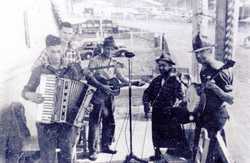Don Doane Sr.’s Katahdin Mountaineers, regarded as the first country band in New England, included Black and White musicians from Yarmouth and the Portland region.
Later called the Katahdin Mountaineers, they played for over thirty years appearing in town halls and opera houses performing music, dance, and comedy in their act. While the players changed over the years, the original group seen in the photograph includes, left to right: Edgar Ruby on accordion, Don Doane Sr. on guitar, an unnamed person, William Abdoul “Shorty” Freeman on fiddle, and David (Hank) Arey with the banjo.
Dick Curless, the Baron of Country Music

Dick Curless publicity photograph, ca. 1965
Maine Historical Society

Dick Curless with horse, Bangor, ca. 1979
Maine Historical Society
Dick Curless (1932-1995) from Fort Fairfield rose to stardom with his 1965 single, A Tombstone Every Mile that highlights his baritone voice. As a teen, he played with Yodeling Slim Clark in Massachusetts under the name, The Tumbleweed Kid. Curless started performing in Maine when he returned from serving in the Korean War. He won a national talent contest hosted by Arthur Godfrey in 1957, and over his career had twenty-two Billboard country hits.
Curless received the nickname, The Baron of Country Music, after his 1966 recording The Baron. Between 1966 and1968, he joined the Buck Owens All American Music Show and appeared at the Hollywood Bowl, Carnegie Hall, and later as a regular member of the WWVA Jamboree U.S.A. in Wheeling, West Virginia. Dick Curless started wearing an eye patch in the mid-1960s on his right eye because of deteriorating vision, and it became part of his signature style on and off stage. Chronic health problems forced Curless to take frequent breaks from the music business, where he returned to Maine to recuperate.
Country musicians in Maine were a close-knit group. Curless worked with luminaries of the generation before him, like Hal Lone Pine and Al Hawkes, and toured with Betty Cody in the 1970s. In 1995, he recorded his last album—some say a masterpiece—Traveling Through just a few months prior to his death at Maine’s Togus VA hospital from stomach cancer.
Allagash Records

Dick Curless record, 1960
Maine Historical Society
Dick Curless and Dan Fulkerson started Allagash Records in Bangor in the early 1960s.
Fulkerson worked as a writer and announcer for WABI in Bangor. He wrote and composed music for Tombstone Every Mile, inspired by driving Route 2A in Aroostook County on the famed Haynesville Road, which he memorialized in the song.
The doom-filled trucking song hit #5 on the country Billboard chart in 1965, and Cash Box magazine named Curless the “Most Promising New Male Vocalist.” Despite his successes, he occasionally left the music business, including in 1962 and 1963 when he worked trucking logs and lumber.
Allagash Records sold over 9,000 copies of Tombstone Every Mile before Tower Records, a division of Capitol Records, purchased the master.

Tombstone Every Mile/Heart Talk, 1965
Maine Historical Society

Tombstone Every Mile, 1966
Maine Historical Society
A Career in Country Music
By Ken Brooks

Choosing a Career in Country and Bluegrass MusicClick to read entire story
I grew up in the small town of Robbinston in eastern Washington County, population around 400. There was a small family band called Stanhope’s Orchestra that played a few times a year at our local grange hall. Their instruments were horns and drums, and their music, for the most part, was the big band dance numbers. I was too shy to consider dancing, but I loved the music.
My family always had a radio and I listened to stations WWVA in Wheeling, West Virginia and CFNB in Fredericton, New Brunswick, Canada, both stations playing all country music. There were a few folks around who played guitar and sang at local grange halls and school events. A teacher in our elementary school, who played piano and taught some music in school, found out that I could sing and encouraged me.
The instrument that I was most drawn to was guitar. I got my first guitar at age 11. I have always enjoyed most genres of music, but country music appealed to me the most. What really captivated me were the stories told (some true, some as if they were true), the way they rhymed, and the way the music—often simple—enhanced those stories. Of course, several instruments would be utilized in making a recording and I enjoyed the interplay of all of them—the rhythm guitar, lead guitar (acoustic or electric), fiddle, drums, steel guitar, banjo, and mandolin.
Having taken an interest in singing, it seems to me that the guitar was the most versatile instrument for accompaniment, and I still love the sound of a good guitar well-played.

